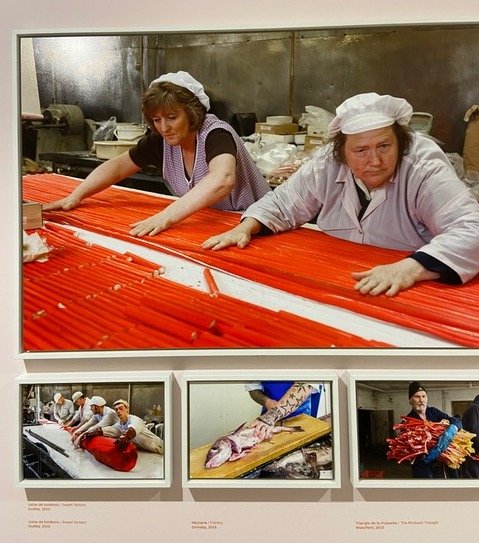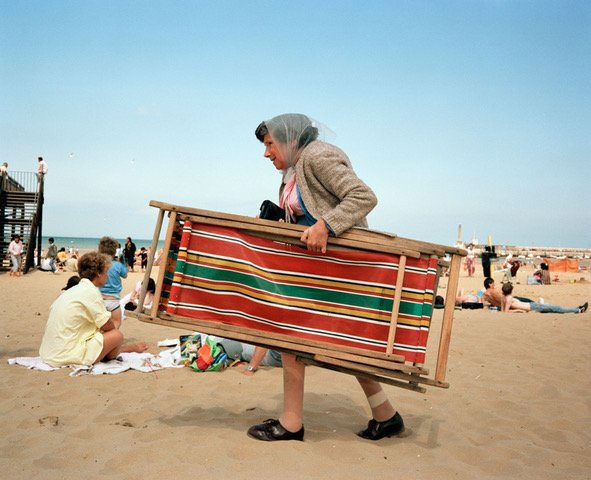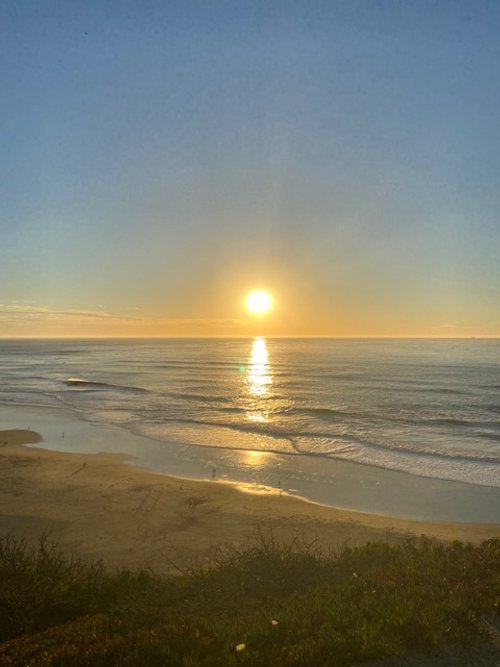Spatchcocked and cooked
Newsletter 11.27.2022
Bienvenue and welcome back to Musée Musings, your idiosyncratic guide to Paris and art. Last week I forgot to tell you about the two exhibitions I saw just before I left Paris for San Francisco. At the Fondation Henri Cartier-Bresson on rue des Archives, where I saw a wonderful exhibition on the photographs of Eugène Atget last summer (many now on permanent display at the Musée Carnavalet). The space has expanded and there’s room for two exhibitions. One exhibition on now pairs Henri Cartier-Bresson (HCB) with the English photographer, Martin Parr. The title, ‘Henri Cartier-Bresson with Martin Parr: Reconciliation,’ lets you know right away that we are going to be seeing photographs by two people who don’t share an aesthetic. And indeed they don’t - among other things, HCB worked in black and white, Parr works in saturated color. (Figures 1, 2) HCB made his lack of sympathy for Parr’s work very clear. It reminded me of how Julia Child reacted to Julie Powell cooking her way through Mastering the Art of French Cooking (as retold in Julie Powell’s book and the film based on it, Julie & Julia). Julia Child never ‘got it’ and her reaction to Julie Powell seemed (to me) both clueless and unkind. HCB on the other hand, eventually came around. He may not have changed his mind, but he eventually accepted Parr’s work.
Figure 1. Liverpool, Henri Cartier-Bresson, 1962
Figure 2. Factory Workers, Martin Parr
In this exhibition, HCB and Parr photographs of the industrial north of England are paired and compared. (Figures 3, 4) A quarter of a century separates HCB’s photographs from Parr’s. (1962, 1986) Another quarter century separates Parr’s first series of photos of this place from his second (2010) (Figure 5).
Figure 3. Liverpool, HCB, 1962
Figure 4. Life’s a Beach, Martin Parr, 1986
Figure 5. Best Pot Leek, Martin Parr, 2010
Here’s a little background. In 1962, HCB’s received a commission from a British television company to take photographs of people in Northern England. (Figure 6) The photos were the focus of a film made the following year. The film is on a constant loop at the exhibition. As you watch the film, “Stop Laughing - this is England,” you can understand why it was never shown. In fact, the film remained unknown until it was discovered in an archive last year.
Figure 6. Letter engaging Henri Cartier-Bresson to take photos in N. England, 1962
To HCB, “England (was) the most exotic place in the world.” To contextualize his photographs, the film’s narrator quotes a Frenchman who got to England before HCB did, Alexis de Tocqueville. Here are a couple things that de Tocqueville wrote to explain the English to the French: French people don’t want superiors. The English want inferiors. The French (and other Europeans) think it’s terrible not to be rich. The English think it’s terrible to be poor. And just one more, everything for the English is work, including vacations. For them, dressed in their Sunday best, vacation is just another form of work.
Martin Parr was born in England in 1952. He is a documentary photographer and photojournalist whose photos are simultaneously humorous and anthropological. He focuses on social class in England. He said that he makes “serious photographs disguised as entertainment.” And it is up to the audience to decide if they want to stay on the surface or go deeper. As one reviewer put it, Parr’s technique “leave(s) viewers with ambiguous emotional reactions, unsure whether to laugh or cry.”
This exhibition is about a subject you have probably not associated with HCB and pairs his work with those of a photographer you may not know. All very satisfying.
BTW, for those of you who get the NYTimes, there is an interactive article by David Botti, called ‘A Mystery Hidden in a Family Photograph’ in which he uses photographs to learn more about his family’s life in Italy, before they emigrated to America. A Henri Cartier-Bresson photograph plays a critical role in unraveling the mystery. If you like Jason Farago’s ‘Close Read’ analysis of paintings in the NYTimes, you will love participating in Botti’s adventure.
There’s another exhibition at the Fondation, about an American painter turned photographer. Jan Groover (1943-2012) was an abstract painter who switched to photography in the 1970s. At the time, she and her husband the artist/critic Bruce Boice, were teaching and making art in New York. Her early still life photographs remind me very much of still life paintings by Giorgio Morandi. (Figures 7, 8). The earliest ones are photographs unedited, not really composed, just whatever was in her kitchen sink when she picked up the camera. (Figure 9)
Figure 7. Still Life, Jan Groover
Figure 8. Still Life, Giorgio Morandi
Figure 9. Kitchen Sink Still Life, Jan Groover
Groover and her husband moved to France in 1991. It was a political gesture. They hated Ronald Regan and decided that if George H.W. Bush was elected president in 1988, it meant that they had nothing in common with their countrymen and it was time to go. When Bush père won, they made good on their word. I knew a lot of people who said they would not stay in the United States if George Bush beat Al Gore in 2000. Some of them did leave (remember I live in San Francisco). But Groover and her husband were ahead of the curve. I was impressed by the strength of their conviction. I wasn’t as impressed with how her still lifes changed. She had more space so she took up more space. She began photographing larger assemblages of stuff on a mat in their garden. (Figure 10) Jan Groover died in France in 2012. There is a video of her husband speaking about her, after her death, which is both moving and informative.
Figure 10. Garden Still Life, Jan Groover
Honestly, how can I help but love Paris. Every time I wander into an exhibition, my horizons expand. These are ‘must see’ exhibitions if you happen to be in Paris.
I flew to San Francisco on Air France on a Wednesday, the week before Thanksgiving. Through some terrible twist of bad luck, or maybe poor planning, I found myself flying Economy. That is not what I wanted. Yes, I bought an economy round trip ticket, but I expected to use miles to upgrade. Which I was able to do (Business Class) for my return flight to Paris. This flight requires, at least for me, some hours of sleep if I want to walk off rather than be wheeled off the airplane.
When I found out that I wouldn’t have enough miles to upgrade on the flight to San Francisco, I tried to buy the upgrade. The upgrade to Business was 1899 euros, the upgrade to economy plus was a 100 euros more. I know, doesn’t make any sense, but when it comes to flights and prices, what does. A little more than I wanted to spend and besides, I knew I would have one more chance when I got to the airport. I had my credit card out to purchase an Economy Plus ticket for 600 euros, a real bargain when I had been quoted 1999 euros only a few days earlier for the same upgrade. As it turned out, the seat had a seat back that didn’t go back. So, economy it was.
The Air France airplane from Paris to San Francisco has 66 Business Class seats, only 24 Economy Plus ones and at the back, in the same amount of space that 66 souls recline in relative comfort, are 200 economy class seats. Let’s not discuss it. I am not quite ready to discuss the indignities of departure and arrival protocols, either. Nor am I ready to tell you what my children and I did for 2 hours between my arrival and our Uber trip home. But soon.
However, basking in the warmth and comfort of being with the people I love best, is a joy. To be in my own home again is a pleasure beyond measure. And San Francisco is so beautiful, the climate is so temperate. With breathtaking views in every direction. (Figures 11, 12, 13) But alas, for a girl who needs culture more than nature, the pleasure is intense mostly because it is temporary!
Figure 11. The two windmills that are frequently my daily walk
Figure 12. My San Francisco sunset,
Figure 13. My San Francisco Sunset 2 - Setting Sun
I hope that if you celebrated Thanksgiving on Thursday, yours was as happy and as delicious a day as mine was. Here’s a rundown of some of the highlights of our meal. The stuffing, called a panade, (Figure 14) is a recipe from 101 Cookbooks based on a Judy Rodgers of Zuni Cafe fame, included lots of jammy onions, gruyere cheese and Firebrand (from Oakland) sourdough batard (with crusts left on). Our new roasted Brussel sprouts recipe from Samin Nosrat, (Figure 15) formerly of the New York Times and author of Salt, Fat, Acid, Heat was fantastic. The recipe reminded Ginevra of her favorite dish when we were in Venice - sarde in saor - fried sardines swimming in sautéed onions, pine nuts and golden raisins soaked in wine. Also on the menu was a family tradition - pearl onions with pancetta - from Marcella Hazen who brought fine Italian cooking to America. While Jacques Pepin has spent a lifetime trying to make French cuisine more accessible to American home cooks, Marcella Hazen spent her lifetime showing how much more sophisticated Italian cooking was then we imagined it to be. Both authors/chefs succeeded admirably. It dawns on me as I write this, that perhaps onions played a central role in this year’s menu.
Figure 14 Panade (stuffing), 101 Cookbooks based upon a recipe by Judy Rodgers, Zuni Cafe, San Francisco
Figure 15. Brussel Sprouts in Saor, Samin Nosrat, New York Times
The highlight of the meal was a turkey recipe conceived by J. Kenji Lopez-Alt, (Figure 16) which we followed exactly. Which you should always do because Lopez-Alt who writes for the New York Times always explains the scientific underpinning of his always excellent recipes. Because the turkey was spatch-cocked, and even though it was nearly 13 pounds, it only took 90 minutes to roast. Because of the dry salt rub applied 24 hours before cooking, it was succulent. Because it was slathered in a herbed mayonnaise marinade, it was golden brown and delicious. If you are going to roast turkey, there is no reason to do it any other way. And I have tried, many other ways. This was the best, as long as you’ve got someone around who’s good with a saw (for spatch-cocking purposes only, of course).
Figure 16. The ultimate in roasted turkey. Spatch-cocked turkey, Kenji Lopez-Alt, New York Times
Melissa Clark’s recipe for pumpkin pie with spices that reminded all of us of chai tea, in a very good way, was the perfect ending to our meal.
The turkey was too big for our small group. By choice. I love turkey leftovers even more than Thanksgiving dinner. We’ve already eaten Turkey Reubens, based a Martha Stewart recipe, substituting sauerkraut for cole slaw. (Figure 17) Today is Turkey Bang-Bang, (Figure 18) a Nigella Lawson NYTimes recipe from years ago which calls for iceberg lettuce, cucumbers, peanut butter and of course, shredded turkey. Mark Bittman’s The Turkey who went to India, another NYTimes recipe has another whole range of flavors. And is also on the rotation. I made soup stock yesterday. One day we’ll have Samin Nasrat’s Turkey Pho (Figure 19) and another, we’ll try another NYTimes recipe, by Sola El-Waylly for stuffing dumpling soup (Figure 20). Which will probably do it for the turkey and us! (All New York TImes recipes available through their subscription recipe database: cooking.nytimes.com which we use all the time, not just Thanksgiving!)
Figure 17. Turkey Reuben, Martha Stewart Living
Figure 18. Bang-Bang Turkey, Nigella Lawson, New York Times, a family favorite since it first appeared twenty years ago today, November 27, 2002
Figure 19. Turkey Pho, Samin Nasrat, New York times
Figure 20. New to the roster this year, Stuffing Dumpling Soup, Sola El-Waylly, New York Times
Since no museum exhibitions are calling out to me here in San Francisco, I am looking forward to writing about all the exhibitions I saw before I left Paris - Proust, of course, but also Munch, Kokoshka, Bonheur, Louis XV and Monet’s 'Impression, Sunrise’!
My post today is on the portrait painter, Alice Neel. I hope you find the artist and her work as interesting as I do.
Below are readers comments for which I am always grateful, a most appropriate feeling for this time of year. Gros Bises, Dr. “B.”
New comment on All Tied Up In Knots: Oh, I wish I was in San Francisco now- lived there for 3 decades, now live in Berlin - to see this artists work. Love how your stories often connect back to the Bay Area. Makes me feel a bit 'homesick' though. Have a fabulous holiday time at home. Ursula, Berlin
New comments on Chocolates and Kings and Proust, oh my…:
Beverly> There is an exhibit somewhere in Paris of the interiors of yet another Orient Express train are on display. I should have noted the location but forgot to make a note. Apparently the interior of the sleepers, dining , club cars are to be as opulent as the original cars. So thought you might be interested in this ‘mobil art display.’ Bill, Columbus, OH
Ma chère Beverly, You must have enjoyed your visit to Versailles of Louis XV “le bien-aimé.” I wonder if you visited the music room where Mozart played for the king. He was still a child. But I think you limited your visit to the gardens. I used to go to concerts and operas in the palace of Versailles. The theater is rather small, all wood, intimate, next to the chapel. Speaking of Proust, last Wednesday my Club commemorated the centennial of his death on 18 November 1922. We listened to his music : violin pieces by Franck, Saint-Saëns and , of course, Reinaldo Hahn, JF, New York & Paris
Dr.Bev, we have french pate de fruits@ Gumps Holiday Shop! Hope to see you & Ginerva soon. Fridays are a good day! Jacquelyn G, S.F. Bay Area
You do get around. I now have the Flucuart on my list for next time in Paris. I hope you and your family had a nice Thanksgiving with lots of hugs . I had planned to zoom the Pentergast program, but the time didn't work out. Deedee, Baltimore




















